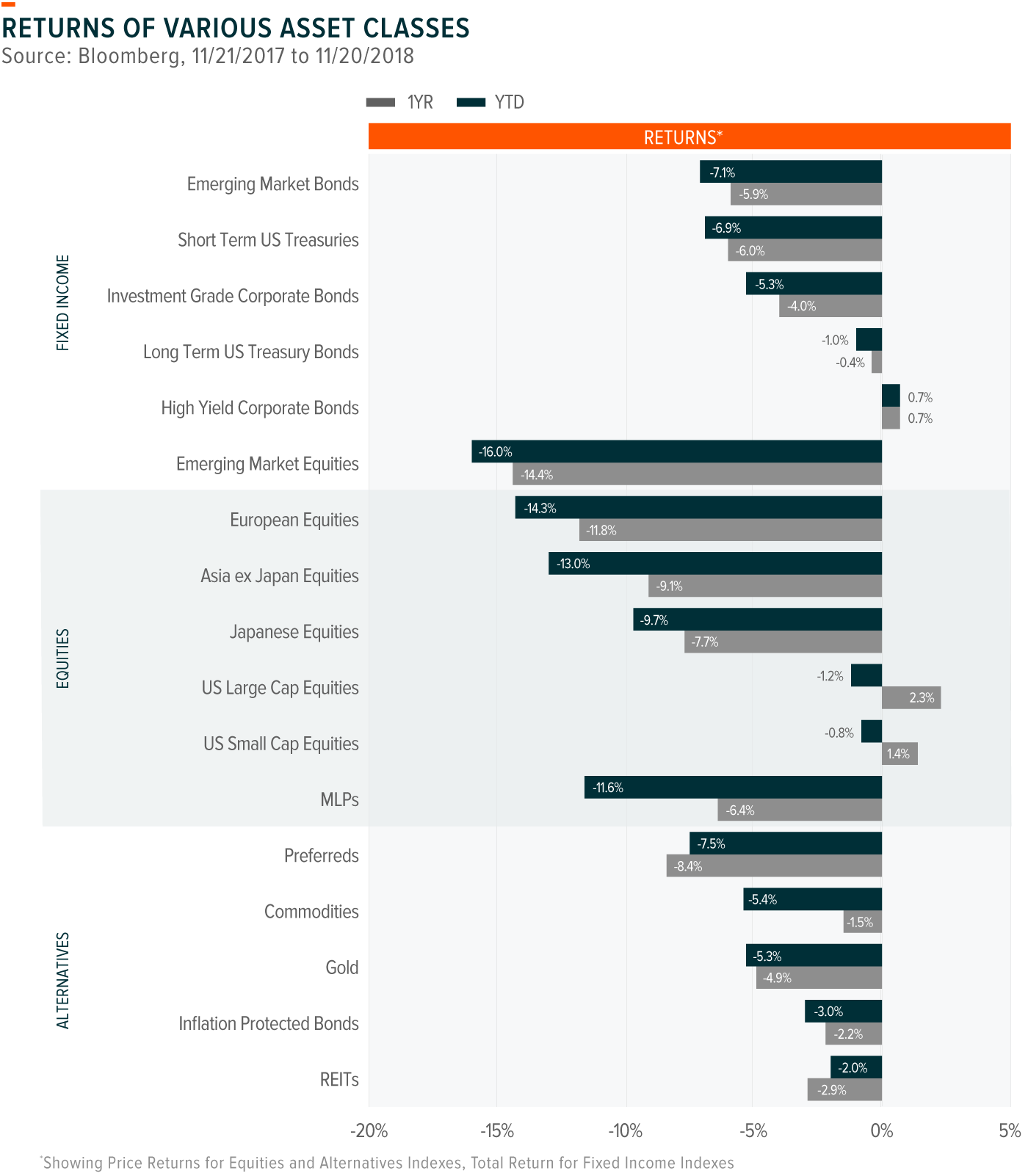Nobody likes to see a broad selloff across asset classes, but investors can still make most of the situation by considering tax loss harvesting opportunities heading into year end. Tax loss harvesting involves selling assets in a portfolio that are below their cost basis, thereby realizing capital losses that can offset realized capital gains in other portions of the portfolio.
Back in 2017, tax loss harvesting proved to be a challenging strategy to implement as many asset classes delivered strong performances, limiting the areas that could be sold at a loss. In such a bullish market, investors can potentially receive higher than expected tax bills in the following April as ordinary turnover in their portfolio, through rebalancing or tactical asset allocation changes, results in realized gains.
This year, however, may be different. Rising interest rates, heightened geopolitical tensions, and slowing global growth forecasts have combined to pressure virtually all major asset classes into negative territory. Investors would be wise to speak to their financial professional about trying to take advantage of this broad selloff by realizing losses and adjusting portfolio exposures ahead of 2019.
A Look at the Returns of Various Asset Classes
In the chart below, we look at the year-to-date and one year performances of indexes representing commonly held asset classes. Of the 17 asset classes considered, just one has demonstrated positive returns in 2018 and three over the past one year period, demonstrating the breadth of the selloff. While actual returns for investments in each of these segments may differ, the chart depicts areas where investors are more or less likely to have opportunities to tax loss harvest.

Index returns are for illustrative purposes only. Index performance returns do not reflect any management fees, transaction costs or expenses. Indexes are unmanaged and one cannot invest directly in an index. Past performance does not guarantee future results. Price Returns reflect the change in price of a security whereas Total Returns consider both the change in price and any dividends received.
3 Considerations for Tax Loss Harvesting
Realign to One’s Strategic Asset Allocation: Selling an investment at a loss is just the first step in tax harvesting. The second is to reinvest cash received from the sale to ensure the portfolio remains aligned with an investor’s objectives. Assuming one’s objectives have not changed, bringing the portfolio back in line with its strategic asset allocation (SAA) is often a priority. Given the severity of the selloffs in certain areas this year like Emerging Market stocks and bonds, European stocks, Asia ex-Japan stocks, and MLPs, it is likely that investors are now under-weight those allocations in their portfolio versus their SAA. Investors may want to consider reallocating capital to those asset classes to bring them back to their target weight.
Evaluate New Tools: It is possible that new offerings are now available since an investment was originally purchased. These new tools could include lower cost access or alternative approaches for targeting a particular asset class. For example, the Global X MLP ETF (MLPA) and Global X U.S Preferred ETF (PFFD) are broad index-tracking exchange traded funds that have management fees that are significantly lower than the asset class’s average. Selling a high fee fund, capturing losses, and reallocating to a lower cost fund could provide a double-benefit to investors. In addition, equity funds that take a multi-factor approach offer investors the potential to outperform market-cap weighted indexes with lower risk. Reallocating from a higher cost actively managed mutual fund to Global X’s Scientific Beta suite covering the US, Europe, Japan, and Asia ex-Japan, or the Global X Adaptive U.S. Factor ETF (AUSF) could help improve a portfolio’s risk-adjusted metrics.
Look for Long Term Opportunities: Investors can potentially use selloffs to their advantage by gaining exposure to long term investment strategies at more attractive valuations. For example, after strong 2017 performance for many disruptive technologies like Robotics & AI and Lithium & Battery Tech, volatility in 2018 and a pullback in tech stocks has brought valuations down to recent lows. When looking to re-deploy cash from sold assets, areas that have demonstrated recent underperformance, yet remain well-positioned to benefit from long term structural trends, may be worth considering.
 Global X Research Team
Global X Research Team